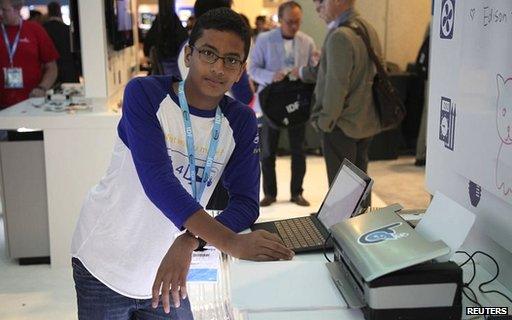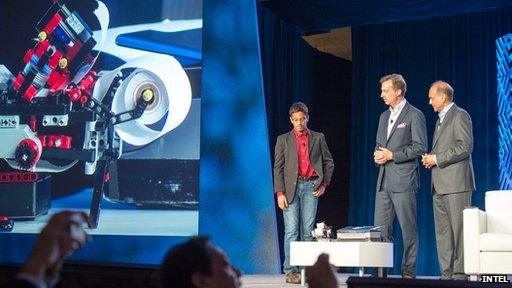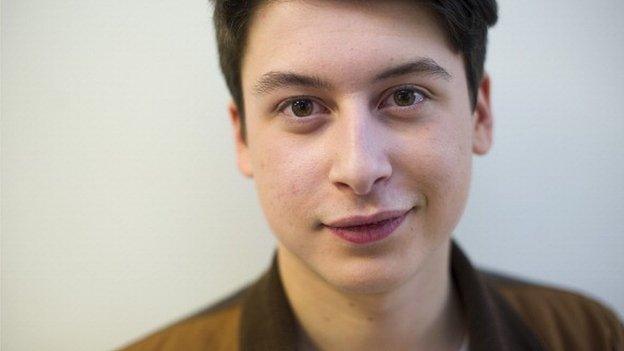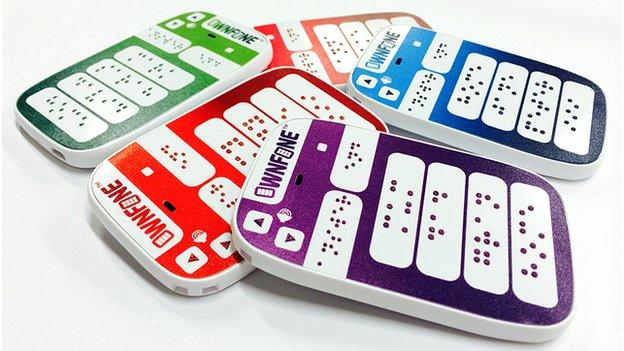Tech giant Intel backs schoolboy inventor
- Published

Mr Banerjee's original Braille printer was made out of Lego robotics parts
A 13-year-old boy from California has secured funding from Intel to bring a low-cost Braille printer to market.
Intel has not disclosed the exact sum it is giving to Shubham Banerjee, but the Reuters news agency reported, external it was "a few hundred thousand dollars".
The teenager rose to prominence after showing off a prototype version made with Lego kit, at the White House, when he was aged just 12.
Only a minority of blind people use Braille.
The Royal National Institute of Blind People (RNIB) estimates that about 4% of visually impaired children and young people in England currently use it.
Even so, the charity greeted the news.
"We welcome investment in technology that aims to improve everyday life for blind and partially sighted people, and especially applaud this brilliant initiative from such a young entrepreneur," said Clive Gardiner, RNIB's head of reading and digital services.

Mr Banerjee showed off an early version of Braigo v2.0 in September
"Electronic Braille has great potential, but has been hindered to date by high device costs for users.
"New innovations for low-cost Braille printers such as this one... can transform reading choices for people with sight loss who read Braille.
"We look forward to hearing more about its progress."
Braille 2.0
Until now, Mr Banerjee's company - Braigo Labs - had relied on $35,000 (£21,920) worth of cash from his parents to turn what was originally a science fair project into a proper Silicon Valley start-up.
The original Braigo v1.0 printer used Lego's Mindstorms EV3 robotics kit as well as parts from a local home renovations store.
Users wrote text via an attached keypad, which the machine then converted into Braille, bashing out the raised bumps on a scroll of paper.
The invention won Mr Banerjee several awards and a place at the White House's inaugural Maker Faire in June, attended by President Barack Obama.
He has since begun work on a follow-up version, which is powered by Intel's budget-priced Edison chip and uses 3D-printed parts.

Intel announced the investment in Braigo Labs at an event in California
"It is less power-hungry and has the future possibilities of using batteries... in remote places of the world," Mr Banerjee said, external when he showed off the work-in-progress at an event hosted by Intel in September.
"The capabilities of Edison enabled me to do a whole set of use cases I hadn't previously thought about.
"For example, when we wake up in the morning we look at our smartphone or tablet to see the headline news.
"With Edison, we've set it up so the CNN headlines are printed off automatically every morning."
The teenager hopes in time to sell a commercial model that will cost around $350 - about a fifth of the price of the lowest-cost alternatives.
But while he is one of the youngest tech entrepreneurs to find success, he is not dedicating his life to the project at this stage.
"It's an after-school thing," he told Reuters.
Such investments can make good business sense for large tech firms.
Yahoo gained both a project chief and a lot of positive publicity when it employed British app developer Nick D'Aloisio in 2013, when he was 17-years-old.
- Published24 September 2014

- Published16 May 2014
